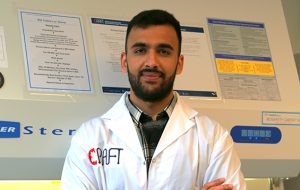CCRM, the publisher of Signals, has enhanced its long-standing relationship with the University of Toronto’s Medicine by Design through a new strategic alliance. This profile is one in a series of profiles that feature “people” of Medicine by Design. Some minor edits may have been made to the original published version.

Sushant Singh, PhD candidate, Department of Mechanical and Industrial Engineering, University of Toronto
“I’m in the biological engineering field. I’m currently a fourth-year PhD candidate in the lab of Axel Guenther. He is the scientific director of the University of Toronto’s Centre for Research and Applications in Fluidic Technologies (CRAFT) facility. Dr. Guenther and his lab have become well known for their innovation in developing 3D printing technology for medical applications. This technology can be used to create sheets of bio-tissue filled with human cells that have the properties of human tissue. For example, we are working on how we can use this bio-tissue for skin grafting for burn victims.
My research work in the Guenther lab focuses on what’s called bioink, a tiny 3D-printed structure in the form of a sheet, which is applied to a wound to promote regeneration and healing. We’re primarily developing this material using novel technologies called microfluidics and collecting data to characterize this material.
I’m really enjoying this work and I’m learning so much from Dr. Guenther and my colleagues on the team. Looking back to where I started my academic journey, it is surprising that I am in the biotech field because that wasn’t my original intention.
When I was growing up in New Delhi, I had a deep passion for cars. I was into the technical aspect of cars and still am a huge fan of auto racing, especially Formula One. I love the raw competitiveness of it. So, I thought I would make a career in automobile engineering.
However, my father has been very influential for me. He thought mechanical engineering would offer me more opportunities and I agreed with him. So, I ended up doing my undergrad in mechanical engineering at SRM University in Chennai, India. During my third year, I became interested in 3D printing, which has revolutionized technology in multiple industries from rocket engineering to skull implants. I was thrilled that I was accepted into a master’s program in materials science and engineering at the University of Toronto (U of T).
The technology we are working on is exciting, as is biotech in general. There is great potential to have an impact in improving people’s mental and physical state of health, which motivates me daily. There are a lot of challenges in taking biotech from the lab to industry. But there is a lot of activity in Toronto by U of T, and programs like Medicine by Design, in creating an environment to translate these technologies and find industrial partners and get this tech to the public.
I participated in Medicine by Design’s Summer by Design program [in summer 2023], along with other trainees from around the world, to learn more about the business aspects of regenerative medicine and how the industry works in Canada. Commercialization is a long and expensive process, so you have to make sure your technology is scientifically sound and that there is a market for it. I think creating companies from research is easy. Keeping the doors open is the tough part.
I like the research, but I’ve always been interested in the business side as well. So, my team and I are working towards getting a start-up off the ground. And it’s a great time to be doing that in the field of regenerative medicine. Toronto has always been one of the strong players in stem cell work and biomedical technology. We have a lot of great ingredients here for success.
I like to work hard. That was ingrained in me by my parents. If I had to go back to when I was a kid and give myself advice, I would tell myself to develop my critical thinking skills and find effective ways of continuous learning and self-development.
As for the coming year, I am looking forward to analyzing the data we’ll be collecting for our 3D-printed structures and I am also excited about our team participating in a lot of entrepreneurial activities, which I hope will lead to company creation and raising venture capital funds to take this technology toward clinical application.”
Sushant Singh is working on developing disposable thermoplastic bioprinting devices for in-situ deposition of biomaterials for skin bioprinting in collaboration with the National Research Council of Canada. He is also working on large-scale production of novel biomaterials to be used in bioprinting produced using high throughput thermoplastic microfluidic devices.
Medicine by Design
Latest posts by Medicine by Design (see all)
- Profile: Vera Pieters, #opentowork - May 2, 2025
- Profile: Jacqueline Getfield, project manager of CARM - October 18, 2024
- Profile: Blair Gage, Scientist, The Ottawa Hospital - August 6, 2024






Comments